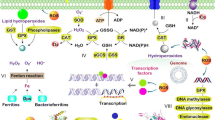Abstract
Exposure to low temperatures induces the biosynthesis of specific sets of proteins, including cold shock proteins (Csps). Since many of the specific functions of pychrophilic Csps are unknown, the roles of Csps from an Arctic bacterium, Polaribacter irgensii KOPRI 22228, were examined. The genes encoding CspA and CspC of P. irgensii were cloned in this study. Sequence analysis showed that these proteins have cold shock domains containing two RNA-binding motifs, RNP1 and RNP2. Both proteins bound oligo(dT)-cellulose resins, suggesting single-stranded nucleic acid-binding activity. When the P. irgensii Csps were overexpressed in Escherichia coli, the cold-resistance of the host was increased by more than five-fold. The P. irgensii Csps also rescued a cold-sensitive E. coli csp-quadruple deletion strain, BX04, at low temperatures. These results suggest that Csps from P. irgensii play a role in survival in polar environments.
Similar content being viewed by others
References
Brinkmeyer, R., K. Knittel, J. Jurgens, H. Weyland, R. Amann, and E. Helmke. 2003. Diversity and structure of bacterial communities in Arctic versus Antarctic pack ice. Appl. Environ. Microbiol. 69, 6610–6619.
D’Amico, S., T. Collins, J.C. Marx, G. Feller, and C. Gerday. 2006. Psychrophilic microorganisms: challenges for life. EMBO Reports 7, 385–389.
Ermolenko, D.N. and G.I. Makhatadze. 2002. Bacterial cold-shock proteins. Cell. Mol. Life Sci. 59, 1902–1913.
Feng, W., R. Tejero, D.E. Zimmerman, M. Inouye, and G.T. Montelione. 1998. Solution NMR structure and backbone dynamics of the major cold-shock protein (CspA) from Escherichia coli: Evidence for conformational dynamics in the single-stranded RNA-binding site. Biochemistry 37, 10881–10896.
Giaquinto, L., P.M.G. Curmi, K.S. Siddiqui, A. Poljak, E. DeLong, S. DasSarma, and R. Cavicchioli. 2007. Structure and function of cold shock proteins in Archaea. J. Bacteriol. 189, 5738–5748.
Goldstein, J., N.S. Pollitt, and M. Inouye. 1990. Major cold shock protein of Escherichia coli. Proc. Natl. Acad. Sci. USA 87, 283–287.
Gumley, A.W. and W.E. Inniss. 1996. Cold shock proteins and cold acclimation proteins in the psychrotrophic bacterium Pseudomonas putida Q5 and its transconjugant. Can. J. Microbiol. 42, 798–803.
Hillier, B.J., H.M. Rodriguez, and L.M. Gregoret. 1998. Coupling protein stability and protein function in Escherichia coli CspA. Fold. Des. 3, 87–93.
Jiang, W., Y. Hou, and M. Inouye. 1997. CspA, the major cold-shock protein of Escherichia coli, is an RNA chaperone. J. Biol. Chem. 272, 196–202.
Jones, P.G. and M. Inouye. 1994. The cold-shock response-a hot topic. Mol. Microbiol. 11, 811–818.
Jones, P.G., R. Krah, S.R. Tafuri, and A.P. Wolffe. 1992. DNA gyrase, CS7.4, and the cold shock response in Escherichia coli. J. Bacteriol. 174, 5798–5802.
Jones, P.G., R.A. VanBogelen, and F.C. Neidhardt. 1987. Induction of proteins in response to low temperature in Escherichia coli. J. Bacteriol. 169, 2092–2095.
Jung, C.H. and H. Im. 2003. A recombinant human α1-antitrypsin variant, M-malton, undergoes a spontaneous conformational conversion into a latent form. J. Microbiol. 41, 335–339.
Jung, Y.H., J.Y. Yi, H. Jung, Y.K. Lee, H.K. Lee, M. Chinnamaranaicker, J.H. Uh, I.S. Jo, E.J. Jung, and H. Im. 2010. Overexpression of cold shock protein A of Psychromonas arctica KOPRI 22215 confers cold-resistance. Protein J. 29, 136–142.
Kim, M.J., Y.K. Lee, H.K. Lee, and H. Im. 2007. Characterization of cold-shock protein A of antarctic Streptomyces sp. AA8321. Protein J. 26, 51–59.
Michel, V., I. Lehoux, G. Depret, P. Anglade, J. Labadie, and M. Hebraud. 1997. The cold shock response of the psychrotrophic bacterium Pseudomonas fragi involves four low-molecular-mass nucleic acid-binding proteins. J. Bacteriol. 179, 7331–7342.
Newkirk, K., W. Feng, W. Jiang, R. Tejero, S.D. Emerson, M. Inouye, and G.T. Montelione. 1994. Solution NMR structure of the major cold shock protein (CspA) from Escherichia coli: identification of a binding epitope for DNA. Proc. Natl. Acad. Sci. USA 91, 5114–5118.
Phadtare, S. 2004. Recent developments in bacterial cold-shock response. Curr. Issues Mol. Biol. 6, 125–136.
Phadtare, S., J. Hwang, K. Severinov, and M. Inouye. 2003. CspB and CspL, thermostable cold-shock proteins from Thermotoga maritima. Genes Cells 8, 801–810.
Schindelin, H., M.A. Marahiel, and U. Heinemann. 1993. Universal nucleic acid-binding domain revealed by crystal structure of the B. subtilis major cold-shock protein. Nature 364, 154–168.
Schindler, T., P.L. Graumann, D. Perl, S. Ma, F.X. Schmid, and M.A. Marahiel. 1999. The family of cold shock proteins of Bacillus subtilis. Stability and dynamics in vitro and in vivo. J. Biol. Chem. 274, 3407–3413.
Schröder, K., P. Graumann, A. Schnuchel, T.A. Holak, and M.A. Marahiel. 1995. Mutational analysis of the putative nucleic acidbinding surface of the cold-shock domain, CspB, revealed an essential role of aromatic and basic residues in binding of singlestranded DNA containing the Y-box motif. Mol. Microbiol. 16, 699–708.
Thompson, J.D., D.G. Higgins, and T.J. Gibson. 1994. CLUSTAL W: improving the sensitivity of progressive multiple sequence alignment through sequence weighting, position-specific gap penalties and weight matrix choice. Nucleic Acids Res. 22, 4673–4680.
Willimsky, G., H. Bang, G. Fischer, and M.A. Marahiel. 1992. Characterization of cspB, a Bacillus subtilis inducible cold shock gene affecting cell viability at low temperatures. J. Bacteriol. 174, 6326–6335.
Wouters, J.A., H. Frenkiel, W.M. deVos, O.P. Kuipers, and T. Abee. 2001. Cold shock proteins of Lactococcus lactis MG1363 are involved in cryoprotection and in the production of cold-induced proteins. Appl. Environ. Microbiol. 67, 5171–5178.
Xia, B., H. Ke, and M. Inouye. 2001. Acquirement of cold sensitivity by quadruple deletion of the cspA family and its suppression by PNPase S1 domain in Escherichia coli. Mol. Microbiol. 40, 179–188.
Yamanaka, K., W. Zheng, E. Crooke, Y.H. Wang, and M. Inouye. 2001. CspD, a novel DNA replication inhibitor induced during the stationary phase in Escherichia coli. Mol. Microbiol. 39, 1572–1584.
Author information
Authors and Affiliations
Corresponding author
Rights and permissions
About this article
Cite this article
Uh, Jh., Jung, Y.H., Lee, Y.K. et al. Rescue of a cold-sensitive mutant at low temperatures by cold shock proteins from Polaribacter irgensii KOPRI 22228. J Microbiol. 48, 798–802 (2010). https://doi.org/10.1007/s12275-010-0402-5
Received:
Accepted:
Published:
Issue Date:
DOI: https://doi.org/10.1007/s12275-010-0402-5




